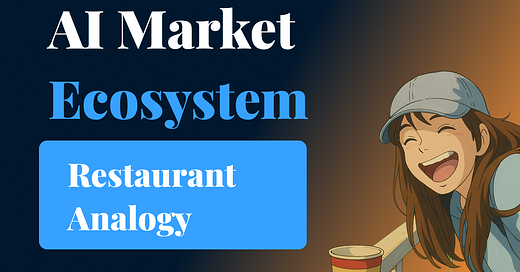Chat GPT, Perplexity, Nvidia, Deep Seek—these and thousands of other names flood our social media feeds and news articles daily. With so much information, grasping a clear picture of the AI market landscape can be overwhelming. But when something feels too big to handle, the best approach is to break it down into smaller and more familiar.
This is the second lesson in our AI learning roadmap, providing a structured framework to understand the AI market. Today, we’ll use a fun and engaging analogy: the restaurant industry.
TL;DR
Apps = Restaurants 🍽️ (serving AI-powered experiences to users)
Models = Recipes & ingredients 📜🥕 (the intelligence and data behind AI)
Infrastructure = Kitchens & equipment 🔥👨🍳 (the power enabling AI operations)
Without infrastructure, models can’t be trained.
Without models, apps have nothing to serve.
Without apps, users can’t experience AI.
The three key parts of the generative AI market landscape
Imagine the generative AI market as a restaurant business. There are three essential components:
1. Apps = The restaurants 🍽️
Restaurants are where customers go to enjoy meals. They don’t grow ingredients or build stoves—they take available resources and turn them into delicious dishes. Similarly, AI applications use pre-built AI models to deliver value to users.
Examples:
Jasper, GitHub Copilot → like a fast-food chain using pre-made AI models to serve text and code quickly.
MidJourney, Runway, Chat GPT → like a fine-dining restaurant that develops its own proprietary recipes.
Key takeaway: Apps take AI models and transform them into products that end users can easily consume.
2. Models = The recipes & ingredients 📜🥕
Just as every restaurant needs recipes and ingredients, AI applications rely on models and training data. Some recipes are proprietary, kept secret by top chefs, while others are shared freely.
Examples:
Closed-source models (GPT-4, Claude) → like a famous chef’s secret sauce, available only in their restaurant.
Open-source models (Stable Diffusion, LLaMA) → like a publicly shared recipe that anyone can use.
Model hubs (Hugging Face, Replicate) → like a grocery store where restaurants get their ingredients and recipes.
Key takeaway: AI models are the core intelligence behind AI applications, turning raw data into valuable results.
3. Infrastructure = The kitchen & equipment 🔥👨🍳
A great recipe is useless without a kitchen, an oven, and proper tools. Similarly, AI requires powerful computing infrastructure to train and operate models.
Examples:
Cloud platforms (AWS, GCP, Azure) → like a rented commercial kitchen where chefs prepare meals.
Compute hardware (Nvidia GPUs, Google TPUs) → like the stoves, blenders, and ovens that enable AI training and inference.
Key takeaway: AI infrastructure provides the computing power necessary for training, running, and scaling AI models.
Apps = Restaurants 🍽️ (serving AI-powered experiences to users)
Models = Recipes & ingredients 📜🥕 (the intelligence and data behind AI)
Infrastructure = Kitchens & equipment 🔥👨🍳 (the power enabling AI operations)
Without infrastructure, models can’t be trained.
Without models, apps have nothing to serve.
Without apps, users can’t experience AI.
All three components must work together—just like in the restaurant industry. Understanding this structure makes navigating the AI market easier and more intuitive. Stay tuned for more lessons on the AI learning roadmap.
We’d love to hear your thoughts! Do you have a different analogy that uniquely explains the AI market? Share your ideas in the comments and let’s discuss!
Next steps: Keep learning and exploring AI
Curious to dive deeper? Check out this more technical article on the generative AI ecosystem, written by one of my key reference sources, the Andreessen Horowitz Blog.
In the next post, I’ll introduce new frameworks to understand the AI app ecosystem better. Stay curious, and let's keep learning together!














Share this post